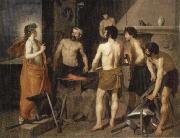Wholesale Oil Painting No Minimum |
|||||||||||
|
|
|||||||||||

|
|||||||||||
|
|
|
||||||||
Velasquez1599-1660,Spanish painter. He was apprenticed to Francisco Herrera the Elder before being trained by Francisco Pacheco. His early works were mostly religious or genre scenes. After arriving in Madrid in 1623, he painted a portrait of Philip IV that won him immediate success and an appointment as court painter. His position gave him access to the royal collections, including works by Titian, who exerted the greatest influence on his style. In his portraits from this period, only the faces and hands of the figures are accentuated, and the dark figures stand out against a light background. A visit to Italy (1629 ?C 31) further developed his style, and on his return to Madrid he entered his most productive period. Velazquez created a new type of informal royal portrait for Philip hunting lodge, and his portraits of court dwarfs display the same discerning eye as those of his royal subjects. On a second visit to Rome (1649 ?C 51) he painted a portrait of Pope Innocent X. The powerful head, brilliant combinations of crimson of the curtain, chair, and cope are painted with fluent technique and almost imperceptible brushstrokes that go far beyond the late manner of Titian and announce the last stage in Velazquez development. This portrait was copied innumerable times and won him immediate and lasting renown in Italy. In his last years he created his masterpiece, Las Meninas (The Maids of Honour, 1656). In this casual scene, the artist is shown painting the king and queen in the presence of the infanta Margarita and her attendants; the nearly life size figures are painted in more or less detail according to their relation to the central figure of the infanta and to the source of light, creating a remarkable illusion of reality never surpassed by Velazquez or any other artist of his age. He is universally acknowledged as one of the giants of Western art. |
||||||||
|
|
||||||||
Smelt Factory
Smelt Factory Painting ID:: 50521 |
mk212
1630
Oil on canvas
222.9x289.9cm
mk212 1630 Oil on canvas 222.9x289.9cm |
|||||||
|
|
||||||||
|
VELAZQUEZ, Diego Rodriguez de Silva y Spanish Baroque Era Painter, 1599-1660 Spanish painter. He was one of the most important European artists of the 17th century, spending his career from 1623 in the service of Philip IV of Spain. His early canvases comprised bodegones and religious paintings, but as a court artist he was largely occupied in executing portraits, while also producing some historical, mythological and further religious works. His painting was deeply affected by the work of Rubens and by Venetian artists, especially Titian, as well as by the experience of two trips (1629-31 and 1649-51) to Italy. Under these joint influences he developed a uniquely personal style characterized by very loose, expressive brushwork. Smelt factory mk237 1630 Oil on canvas 222x290cm |
||||||||
|
|
||||||||
|
Prev Next
|
||||||||
|
|
||||||||
|
Related Paintings to VELAZQUEZ, Diego Rodriguez de Silva y :. |
||||||||
|
|
||||||||
|
CONTACT US |

